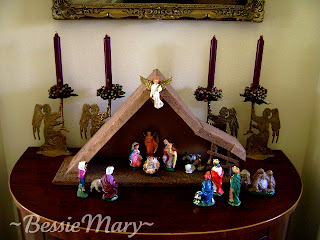Mayo 7 West is where I reported for all vision tests, appointments and meetings with my surgeon.
Surgery was performed at Saint Marys Hospital, located a few miles down the street from the Mayo Clinic.
I do not have any photographs of the hospital, and really wish I did. One end of the lobby was filled with a towering Christmas tree comprised only of fresh red poinsettias. A life size creche was at its base.
Saint Marys Hospital serves only Mayo patients and is staffed exclusively by Mayo Clinic physicians. After Rochester suffered a devastating tornado in 1883, Mother Alfred Moes and the Sisters of Saint Francis wished to build a hospital for the sick and injured residents of Southern Minnesota. Their one condition was that William Mayo and his sons provide the medical services. An agreement was reached and the hospital opened with 27 beds in 1889. It now has 1265 beds.
The morning of surgery would be one of the coldest of our visit. With temperatures at -10, and wind chill factor closer to -20, we were a pair of icicles as we headed to our car.
When I first began speaking with representatives from the clinic and city hotels, they often referred to the parking "ramps". It all sounded a little strange to me. In Dallas, almost every professional building, hospital, shopping mall, convention center, hotel and even churches have parking "garages". I was informed by a Minnesota friend that a garage is an enclosed structure, and a ramp is not. Well, the public parking garages in Texas are not normally enclosed, but we also do not receive three feet of snow and experience sub-zero temperatures on a regular basis!
Much of the 2nd Street Parking Ramp, attached to our hotel, was inaccessible due to piles and drifts of snow, but I digress.
Through an icy parking ramp and streets, we crunched our way to Saint Marys. The hour of our arrival and departure was outside the normal operating times of the hospital shuttle.
We were quickly met in the lobby by an escort and taken to my room. I was given a hospital gown in a shade of blue that coordinated nicely with my frozen nose and lips.
A nurse with a great sense of humor wheeled me toward the pre-op waiting room. Christmas carols were softly playing, and I was issued one more item-- the ever fetching papery shower-cap-looking-thingy. They really know how to make a girl feel lovely! Dr. H, suddenly appeared at my side and inked his initials onto my forehead above each eye. He promised that when it was all over, I would be left only with aligned eyes and not his monogram.
I believed him.
During surgery, the thickened and tight muscles preventing my eyes from focusing properly would be detached. They would then be reattached farther back on the eye, allowing proper muscle coordination and focusing. The incisions were made in the conjunctiva, the thin covering over the white of the eye.
Dr. H determined measurements for relocation through earlier vision tests and examinations. Surgery lasted three hours. I woke in Recovery to the all-too-familiar question of rating pain on a scale of 1 to 10.
At that point, 10 might not have been high enough -- especially after I was informed that Dr. H preferred no additional pain medication. The procedure used is called adjustable suture surgery. I would need to be awake and coherent for the second part of the procedure which would take place a few hours later.
I considered requesting being wheeled outside and allowed to bury my head in one of the many piles of snow to ease the pain. However, I feared that might be frowned upon.
Instead, I asked one of the nurses to describe the appearance of my eyes.
Let's just say she lied. She was very kind, but not at all truthful!
These are my lovely sci-fi horror movie eyes about two or three days after surgery.
They were so red they glowed. Quite apppropriate for the season!
In the photograph, at the tip of each arrow, is a black blob. Those are sutures at the site of the incisions. There is one more incision, in each eye, beneath the lower lid.
About three hours after returning to my room, Dr. H arrived to evaluate eye alignment.
The suture threads were several inches long, trailing out of my eyes, and taped to my cheeks. He could adjust the tension on the muscles through the temporary suture knots, if necessary.
He told me it would tickle.
A word of caution: if a doctor tells you it will tickle, do not believe him.
The surface of my eyes were anesthetized with drops.
The sutures were tied with permanent knots and still remain in my eyes today. Those in the above photograph should dissolve in time.
The ones beneath the lower lids were made with permanent suture thread for added stability. They will be removed during my follow-up visit in February.
My eyes are now slightly less red. They usually feel gritty and dry. After surgery, I was placed on a regimen of steroid, antibiotic and lubricant eye drops. The antibiotics have now ceased, but steroid and lubricant eye drops continue. I will most likely always require the use of artificial tears or lubricant eye drops.
Once Dr. H and the nurses were confident that I was able to walk down the hall, eat, drink and use the restroom, I was discharged. We spent about 12 hours at Saint Marys. We crunched our way back through the icy streets to our hotel, where I would spend the next three days recuperating.
Bright and cheerful flowers from a dear friend would brighten our room.
Emails, texts and phone calls would lessen the pain, provide encouragement and remind us that we were constantly held in prayer.
At the end of the week, Dr. H informed us that I had surpassed even his expectations. I informed him it was obviously the result of so many prayers on my and his behalf. I honestly believe that.
Prior to surgery, distant vision was worse and near vision was better. After surgery, it is the opposite. It will take time for my eyes, muscles and brain to adjust to the changes and learn to work together again.
Ideally, my vision should continue to improve over the next 6-8 weeks as healing continues.
There is also a chance that it could begin to deteriorate.
I will always have Graves Disease. I will always have thyroid eye disease. There will probably always be slight double vision when I turn my head too quickly, or look in certain directions. I may never again be able to wear my contact lens. However, many prayers have been answered. Many things once again bring great joy, instead of frustration and anger. Life will return to normal, or a new normal.
As we bid Dr. H farewell, I had to inquire why he would leave his homeland of England and travel to one of the coldest regions of our country. His first response was "romance". That made me smile! Somewhere along the way, he met and married an American.
He went on to inform us that he would never have as many opportunities in England to research, teach and practice his chosen field of medicine.
No doubt, there is room for improvement in the way health care is managed in our country. Yet, we are also fortunate to be a country where many are eager to come, learn, treat and teach others.
Throughout my time at Mayo, I was struck how many times staff members told me how much they love what they do, and it is obvious they are being sincere.
I am fortunate to have the resources and knowledge to seek the finest care. I realize that is not always true for others. It is my hope and prayer that someday it will be.
I am forever grateful for a doctor willing to take a chance on a difficult case such as mine.
I am also forever grateful for each of you, your prayers, your support and your encouragement.
I believe God's timing is perfect.
It is almost a new year.
It is time to begin stitching, creating and celebrating life again.
It is time to have fun again!









































































